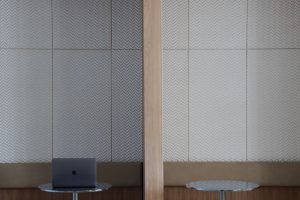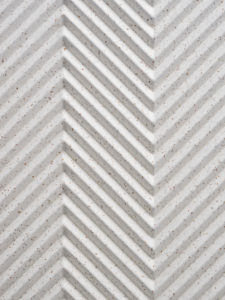Interview #54 Lisa Grape

Text: Matt Carey
Interview: Lisa Grape
Photo: Elin Grape
Case: House of J.Lindeberg
All around the world, architects and designers are using BAUX Acoustic Tiles and Panels in exciting projects for great brands. In a series of newsletters, we aim to introduce you to a selection of projects and the mind masters behind the designs of these acoustic artworks. Why? Because there are endless design possibilities to share with the world. We simply will call these newsletters Interviews #.

This week, we’ve been talking to Lisa Grape from Joyn Studio about the design of J.Lindeberg’s new headquarters in Stockholm.
Q: How did you start your involvement with the project?
We were brought in to look at how J.Lindeberg’s brand could be expressed in their physical workplace. After the pandemic, the big challenge was how to make the office attractive again — somewhere people wanted to come back to. That’s when we developed the concept: House of J.Lindeberg — a workplace that balances focus, collaboration, and identity, while really reflecting the energy and style of the brand.
Q: What were some of the challenges on the project?
One of the biggest challenges of office work is sound. People had become used to quiet home offices, and when they came back, the noise of open workspaces and cafés felt overwhelming. We knew we had to address acoustics properly to make the office comfortable — especially with so many digital meetings happening now. If the space wasn’t functional in that way, people simply wouldn’t want to use it.
Q: How is the workspace organised to support different teams?
It’s a mix of activity-based areas and more traditional desk setups. Some spaces are unassigned so people can choose where to work, while product design and development have their own desks. Finance and admin teams share their area. What we’ve seen is that people are spending more time in meetings now — both digital and face-to-face — so it was important to add more meeting rooms, as well as places to take breaks and relax.
Q: Why was BAUX Acoustic Pulp the right material for the project?
Acoustic Pulp aligned perfectly with J.Lindeberg’s wishes for sustainable material choices. The material feels very natural and also had an aesthetic quality that felt closely connected to the brand — the matte white surface reminded us of snow, which fits with J.Lindeberg’s ski heritage. It has that sense of nature and performance at the same time.
Q: How did the BAUX designs change the space?
In the café and work lounge, we used Pulp to soften echoes and create a calmer, more comfortable environment. The space isn’t just functional — the BAUX designs add warmth, tactility, and a subtle pattern that makes the walls feel alive rather than flat.
Q: How did the BAUX designs help to communicate the brand platform?
For us, the office was always about building a physical brand platform. BAUX helped us do that because it’s not just an acoustic solution — it’s sustainable, premium, and connected to Scandinavian nature, which mirrors the sports and fashion DNA of the J.Lindeberg brand.

Products used
Acoustic Pulp
Natural Wheat
Feel free to download all files intended to help working professionals design, sketch and construct sustainable acoustical sound environments for large and small spaces.